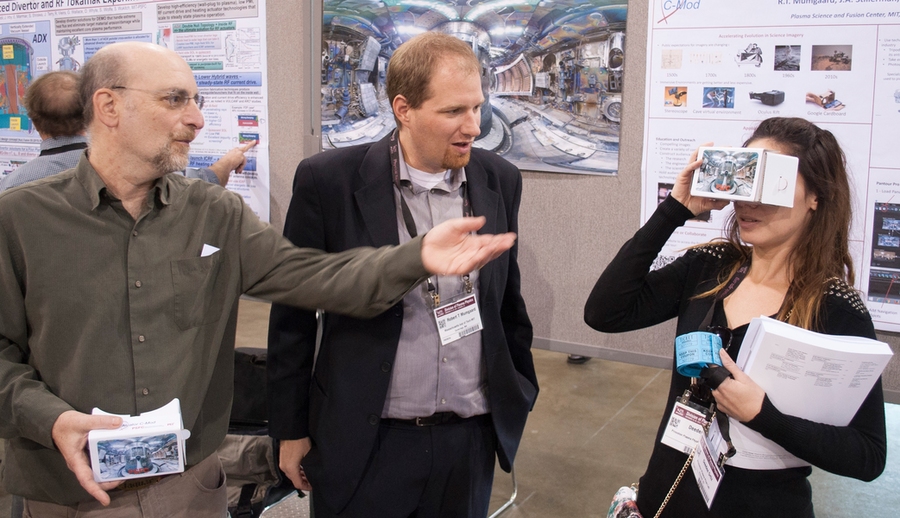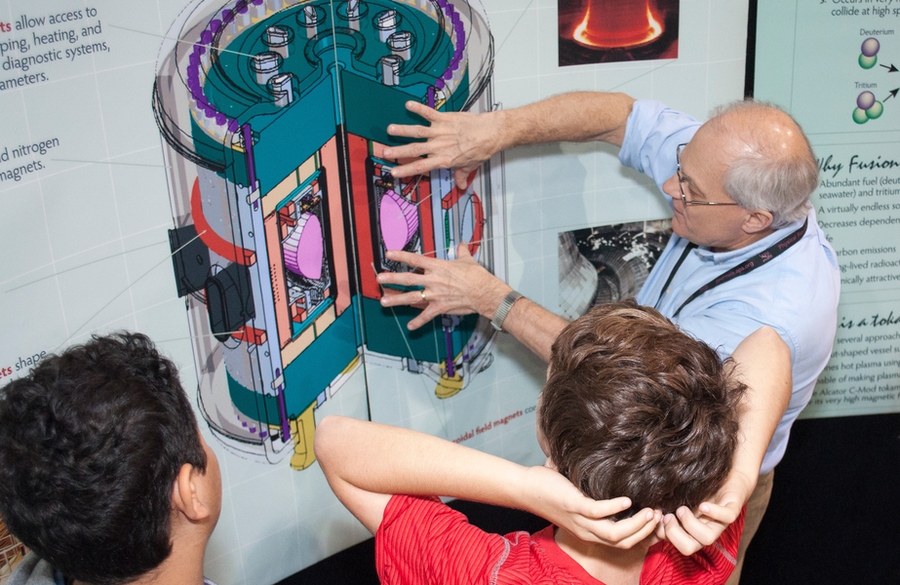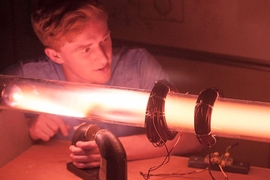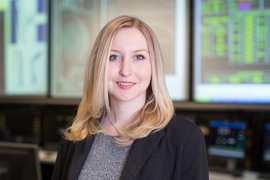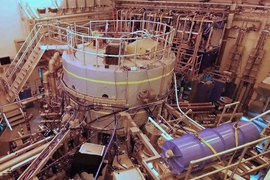When members of the MIT Plasma Science and Fusion Center (PSFC) community attended the American Physical Society — Division of Plasma Physics (APS-DPP) meeting in Savannah, Georgia, Nov. 16-20, it was not only to present their most recent research. Alongside the invited talks, chaired sessions, and posters, the PSFC participated in and helped to organize outreach ventures targeting their fellow scientists, students, and the general public. This year, PSFC contributed to the annual Teachers Day and Plasma Sciences Expo with an introduction of a new 3-D tour of MIT's tokamak nuclear fusion experiment.
Using a cardboard 3-D viewer, PSFC Data System Manager Josh Stillerman and postdoc Bob Mumgaard offered glances into the inner workings of MIT's Alcator C-Mod tokamak at a poster session devoted to the latest science from C-Mod. “Bring the viewer to your eyes, adjust the lenses, and you find yourself in the C-Mod vacuum chamber, able to look up, down and around the machine,” Stillerman says. Focusing on specific word doorways allows you to leap outside the tokamak and into the environment around the machine, the power supply room, and even the control room. To create the effects, Mumgaard used high-resolution images he had stitched together into panoramas, having them rendered into 3-D by Kolor software.
Participants responded to the 3-D tour with awe and delight, holding the viewer to their face, turning completely around, walking forward and back while simultaneously looking in every direction. Although the PSFC has begun to explore this technology for outreach purposes, the center is interested in further applications. “Engineering staff has expressed an interest in the software as a way of understanding spatial relationships inside the machine,” Stillerman says. “If you are going to put a diagnostic in, does it fit? What is the line of sight? Is it obstructed?” Stillerman also noted that the PSFC is pursuing using this software to look at data from experiments and simulation codes in a 3-D environment.
The 3-D tour also made an impression at the Plasma Sciences Expo, where it was one of several demonstrations available at the PSFC booth. The expo, which has been a part of the APS-DPP meeting for 20 years, invites middle and high school students, and the general public, to interact with plasma researchers, and watch demonstrations that will help clarify some of the science behind plasmas and fusion. The PSFC also offered students a chance to play a video game that encourages them to work cooperatively to keep a fusion plasma magnetically contained within the Alcator C-Mod tokamak. A “plasma sword,” or neon wand, also attracted a lot of attention, allowing students to create a plasma simply by holding or touching the sword in a way that would complete the circuit and charge the gas in the wand.
The PSFC was joined by other plasma centers and laboratories, including many collaborators, such as General Atomics, the Princeton Plasma Physics Laboratory, Lawrence Livermore National Laboratory, the University of Rochester’s Laboratory for Laser Energetic, and the University of Wisconsin at Madison. Over a two-day period, the expo — which is sponsored, in part, by the U.S. Department of Energy Office of Fusion Energy Sciences — hosted over 2,500 area students.
Many teachers accompanying their students had prepared for the expo at a Teachers Day held earlier in the week, where they received a “Fusion 101” course tailored to their students' grade level, and workshops on such topics as how to bring plasmas into the classroom, the electromagnetic spectrum, and even learning physics through comics. The day included a lunch with scientists, several from MIT. Ten teachers received $200 prizes for classroom laboratory equipment, sponsored by the Coalition for Plasma Science, an educational organization supported by the PSFC.
Savannah teachers were grateful for the interaction with scientists, and for the “goodie bags” provided as they left, which included plasma balls and half-coated fluorescent tubes. They reported that, with the knowledge they gained from Teachers Day and the Plasma Sciences Expo, they were more confident introducing their students to plasma, and discussing the possibilities of current research in facilities across the world.
